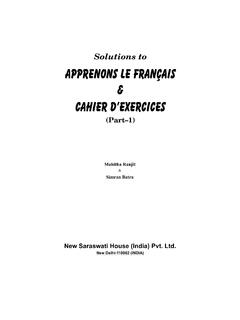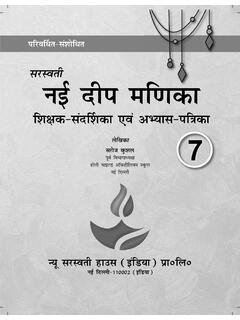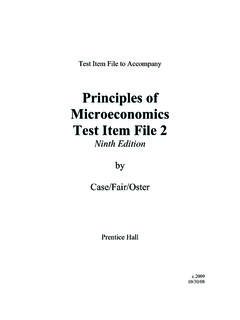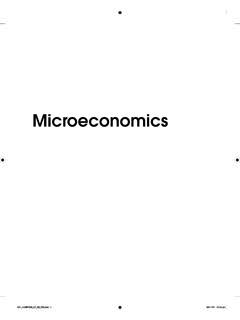Transcription of Saraswati introductory microeconomics
1 Strictly in accordance with the latest syllabus prescribed by CBSE, New Delhi and adopted by various boards, like Haryana School Education Board, Bhiwani; Jharkhand Academic Council, Ranchi; and Bihar School Examination Board, [For Class xi]ByDr. DeepashreeAssociate Professor in EconomicsDepartment of CommerceShri Ram College of CommerceUniversity of Delhi, DelhiNew Saraswati House (india) Pvt. Delhi-110002 (INDIA)Second Floor, MGM Tower, 19 Ansari Road, Daryaganj, New Delhi-110002 (India) Phone : +91-11-43556600 Fax : +91-11-43556688E-mail : : : U22110DL2013 PTC262320 Import-Export Licence No. 0513086293 Branches: Ahmedabad (079) 22160722 Bengaluru (080) 26619880, 26676396 Bhopal +91-7554003654 Chennai (044) 28416531 Dehradun 09837452852 Guwahati (0361) 2457198 Hyderabad (040) 42615566 Jaipur (0141) 4006022 Jalandhar (0181) 4642600, 4643600 Kochi (0484) 4033369 Kolkata (033) 40042314 Lucknow (0522) 4062517 Mumbai (022) 28737050, 28737090 Nagpur +91-7066149006 Patna (0612) 2275403 Ranchi (0651) 2244654 New edition 2018 ISBN: 978-93-5272-518-2 Published by: New Saraswati House (India) Pvt.
2 Ansari Road, Daryaganj, New Delhi-110002 (India)The moral rights of the author has been asserted. Reserved with the PublishersAll rights reserved under the Copyright Act. No part of this publication may be reproduced, transcribed, transmitted, stored in a retrieval system or translated into any language or computer, in any form or by any means, electronic, mechanical, magnetic, optical, chemical, manual, photocopy or otherwise without the prior permission of the copyright owner. Any person who does any unauthorised act in relation to this publication may be liable to criminal prosecution and civil claims for at: Vikas Publishing House Pvt. Ltd., Sahibabad (Uttar Pradesh)Product Code: NSS3 IME110 ECNAB17 CBN This book is meant for educational and learning purposes. The author(s) of the book has/have taken all reasonable care to ensure that the contents of the book do not violate any copyright or other intellectual property rights of any person in any manner whatsoever.
3 In the event the author(s) has/have been unable to track any source and if any copyright has been inadvertently infringed, please notify the publisher in writing for any corrective gives me great pleasure in presenting the revised edition of Saraswati introductory microeconomics , according to the latest syllabus prescribed by unique features of this book are: Clear and precise exposition of the subject. A brief chapter Scheme outlining the contents of the chapter . The analysis in each chapter is developed in a step-by-step, systematic manner, based on logical reasoning. Points to Remember have been given at the end of every chapter . Chapterwise questions under the heading Test Your Knowledge have been given to enhance and cross-check the understanding of the subject. They are set on the pattern of the Board examination. Seven unsolved Practice Papers. A large number of figures, examples and tables give complete knowledge of various concepts.
4 A large number of solved numerical problems have also been given. Many new concepts given in NCERT book have been given under the title Annexure. Completely covers the NCERT book and CBSE supplementary reading. Value Based and Higher Order Thinking Questions (HoTS Questions) with answers have been given at the end of each unit. Answers to NCERT textual questions have been given at the end of each unit. MCQs have been included in every book is a product of thirty three years of my teaching experience and personal interaction with the commerce and economics students at Shri Ram College of Commerce, University of Delhi, Delhi. Through them, I have learnt the needs and requirements of the senior secondary school students. I am of the opinion that such students must be made to imbibe fundamental knowledge in a simple and scientific the years, I have received many suggestions from teachers and students.
5 I am thankful to them for their valuable am specially thankful to the Publisher, New Saraswati House (India) Pvt. Ltd., for giving me an opportunity to work for but not the least, my heartfelt gratitude to Sushil, Sudeep and Saumya. Without their love and cooperation, I would have never been able to complete this 2018Dr. 80 Marks 3 Hours Project: 20 MarksUnits MarksPeriodsPart A: introductory microeconomics 1. Introduction 4 8 2. Consumer s Equilibrium and Demand 13 32 3. Producer Behaviour and Supply 13 32 4. Forms of Market and Price Determination under Perfect Competition with Simple Applications 10 28 40 100 Part B: Statistics for Economics 1. Introduction 13 7 2. Collection, organisation and Presentation of Data 27 3. Statistical Tools and Interpretation 27 66 40 100 Part C: Project Work 20 20 PART A introductory microeconomics Unit 1 : Introduction (8 Periods) Meaning of microeconomics and macroeconomics; positive and normative economics What is an economy?
6 Central problems of an economy: what, how and for whom to produce; concepts of production possibility frontier and opportunity cost. Unit 2 : Consumer s Equilibrium and Demand (32 Periods) Consumer s equilibrium meaning of utility, marginal utility, law of diminishing marginal utility, conditions of consumer s equilibrium using marginal utility analysis. Indifference curve analysis of consumer s equilibrium the consumer s budget (budget set and budget line), preferences of the consumer (indifference curve, indifference map) and conditions of consumer s equilibrium. Demand, market demand, determinants of demand, demand schedule, demand curve and its slope, movement along and shifts in the demand curve; price elasticity of demand factors affecting price elasticity of demand; measurement of price elasticity of demand percentage-change 3 : Producer Behaviour and Supply (32 Periods) Meaning of Production Function: Short-Run and Long-Run.
7 Total Product, Average Product and Marginal Product. Returns to a Factor. Cost: Short run costs total cost, total fixed cost, total variable cost; Average cost; Average fixed cost, average variable cost and marginal cost meaning and their relationships. Revenue-total, average and marginal revenue: meaning and their relationship. Producer s equilibrium meaning and its conditions in terms of marginal revenue- marginal cost.(v)(vi) Supply, market supply, determinants of supply, supply schedule, supply curve and its slope, movements along and shifts in supply curve, price elasticity of supply; measurement of price elasticity of supply percentage-change 4 : Forms of Market and Price Determination under Perfect Competition with Simple Applications (28 Periods) Perfect competition Features; Determination of market equilibrium and effects of shifts in demand and supply.
8 Other Market Forms monopoly, monopolistic competition, oligopoly their meaning and features. Simple Applications of Demand and Supply: Price ceiling, price B STATISTICS FOR ECONOMICS In this course, the learners are expected to acquire skills in collection, organisation and presentation of quantitative and qualitative information pertaining to various simple economic aspects systematically. It also intends to provide some basic statistical tools to analyse, and interpret any economic information and draw appropriate inferences. In this process, the learners are also expected to understand the behaviour of various economic data. Unit-1 : Introduction (7 Periods) What is Economics? Meaning, scope functions and importance of statistics in Economics Unit-2 : Collection, Organisation and Presentation of Data (27 Periods) Collection of data.
9 Sources of data primary and secondary; how basic data is collected, with concepts of samplings; Sampling and Non-sampling errors; methods of collecting data; some important sources of secondary data: Census of India and National Sample Survey organisation. Organisation of Data. Meaning and types of variables; Frequency Distribution. Presentation of Data. Tabular Presentation and Diagrammatic Presentation of Data: (i) Geometric forms (bar diagrams and pie diagrams), (ii) Frequency diagrams (histogram, polygon and ogive) and (iii) Arithmetic line graphs (time series graph). Unit-3 : Statistical Tools and Interpretation (66 Periods) (For all the numerical problems and solutions, the appropriate economic interpretation may be attempted. This means, the students need to solve the problems and provide interpretation for the results derived.)
10 Measures of Central Tendency. Mean (simple and weighted), median and mode. Measures of Dispersion. Absolute dispersion (range, quartile deviation, mean deviation and standard deviation); relative dispersion (co-efficient of range, co-efficient of quartile-deviation, co-efficient of mean deviation, co-efficient of variation); Lorenz Curve: Meaning, construction and its application. Correlation. Meaning and properties scatter diagram; Measures of correlation Karl Pearson s method (two variables ungrouped data) Spearman s rank correlation. Introduction to Index Numbers. Meaning, types wholesale price index, consumer price index and index of industrial production, uses of index numbers; Inflation and index numbers. PART C: DEVElOPINg PROjECTS IN ECONOMICS (20 Periods) The students may be encouraged to develop projects, as per the suggested project guidelines.







